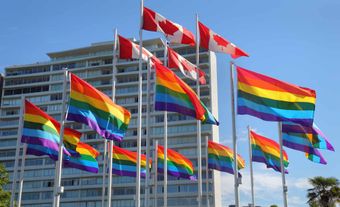Transgender, often shortened to trans, is an umbrella term referring to people whose gender does not align with the sex they were assigned at birth. The first clinic in Canada dedicated to transgender health care opened in 1969. Starting in the 1970s, a wider transgender rights movement began building momentum. The last few decades have seen a greater social understanding of trans issues and advancements in trans rights. However, recent years have also seen an increase in anti-trans sentiment and discrimination. The 2021 Canadian census found that 0.33 per cent of the population over 15 — around 1 in 300 people — identified as transgender or non-binary.

Definition and Background
Transgender is a broad term that includes transgender men, transgender women and non-binary people who do not feel their gender is entirely represented by just man or woman. Non-binary is its own umbrella term that can include people who identify as genderless or agender, genderfluid, genderqueer, with a third or another gender, or in any other way that is not binary. (See Gender Identity.) However, not all non-binary people may identify as transgender. (See also Two-Spirit.)
Trans people often transition socially by changing their appearance, clothing, name or pronouns. Legal transition involves changing names or gender markers on identity documents. This can often pose bureaucratic challenges. Medical transition can include hormone replacement therapy or gender-affirming surgery. Gender-affirming health care is vitally important for those who want and need it, though not all trans, non-binary or gender non-conforming people choose to medically transition.
Did you know?
Gender dysphoria is the term for discomfort that trans people can experience due to the disconnect between their gender and their assigned sex.
Gender Variance Among Indigenous Peoples
Many Indigenous peoples have cultural concepts for people who do not identify with the gender they were assigned at birth (see Two-Spirit). At least 155 nations have gender traditions outside the heterosexual binary or traditional cisgender norms (where gender aligns with sex at birth). The Ojibwe, for instance, used the term ikwekaazo for people assigned as male at birth who took on traditionally female roles. For people assigned as female at birth who took on traditionally male roles, they used the term ininiikaazo.
European settlers imposed a gender binary on Indigenous peoples as part of the colonialization process. Professor Deborah A. Miranda used the term “gendercide” to describe the elimination of Indigenous people that did not conform to the gender binary by settlers. (See Genocide and Indigenous Peoples in Canada.)
Medical Transition in Canada
Modern research into gender dysphoria stretches back at least a hundred years. In 1910, German physician Magnus Hirschfeld created a medical term for transgender identities. In the 1950s, Christine Jorgensen, an American trans woman, rose to fame after having gender affirmative surgeries. Jorgensen helped bring trans issues into the North American consciousness.
The first gender identity clinic in Canada opened at the Clarke Institute of Psychiatry in Toronto (“the Clarke”) in 1969. The first widely publicized gender-affirming surgery in Canada was performed in Toronto in 1970 on Dianna Boileau.
In 1973, the Centre Métropolitain de Chirurgie Plastique (now known as Centre Métropolitain de Chirurgie [CMC]) opened in Montreal as a private clinic. The CMC was the first surgical centre in Canada to offer gender-affirming lower surgery. It was the only clinic in Canada performing vaginoplasties (the creation of feminized genitalia for trans women) for 45 years. Trans surgical centres opened at the Women’s College Hospital in Toronto in 2017, and the Vancouver General Hospital in 2019.
Early on, medical transitions were originally strictly controlled by psychiatrists. Provincial health coverage only funded gender-affirming surgeries for patients diagnosed as transgender. Diagnosis involved undergoing a large number of invasive and personal tests. Some of the tests were the same as used on criminal sex offenders that the Clarke also treated. Patients at the time described the Clarke as being more interested in researching trans people than helping them. The institution had a negative reputation among trans people.
Surgeons would only operate on people who had been approved for surgery by a clinic or a psychiatrist. Moreover, the Clarke only approved applicants who had a job, were straight, single and had never been convicted of a crime. They wanted people who would be able to “pass” as cisgender and conform to binary gender roles.
Approval for surgery took numerous assessments over at least two years. Applicants were required to live as their gender for at least two years before accessing surgery. They also needed to change all their legal documents. This was difficult, as there were long backlogs involved in updating birth certificates. Combined with the Clarke’s strict standards, this meant few approvals. Betty Steiner, the clinic’s director, told the Toronto Star in 1982 that out of 600 applicants, only 75 were approved for surgeries.
By the end of the 1970s, access to many gender-affirming surgeries and hormones was available but strictly limited. This led to some trans people in Canada seeking surgical care abroad, with varying results.
In the 1990s, provincial funding for gender-affirming surgeries in Ontario became a political football as governments considered delisting procedures to cut costs. In 1998, Mike Harris’s Progressive Conservative government suspended coverage. It was not reinstated until 2008, after a decade of campaigning by local trans activists.
In Quebec, patients having gender-affirming surgeries were typically sent abroad. It took decades for Quebecois patients to be able to have surgery in-province. Surgeries performed at private clinics like CMC were not covered by provincial health care until 2009.
Currently, many provinces and territories still require notes from mental health care providers to allow patients to access medical transition care. The types of health care available are often limited to hormone replacement therapy, genital surgeries and some chest surgeries.
In 2021, Yukon expanded its health care program to cover all transition-related care. As a result, Yukon has the most comprehensive trans health coverage in Canada. However, it still requires a referral from a mental health provider to access.
Take the quiz!
Test your knowledge of the 2SLGBTQ+ community in Canada by taking this quiz, offered by the Citizenship Challenge! A program of Historica Canada, the Citizenship Challenge invites Canadians to test their national knowledge by taking a mock citizenship exam, as well as other themed quizzes.
Transgender Legal Rights
Trans people have long been targeted by hate and discrimination. Employment discrimination led to disproportionate numbers of trans people turning to sex work. The police were known to arrest trans women on the assumption that they were sex workers due to “cross-dressing.” Trans people could rarely access gender-affirming health care inside prison. Moreover, a criminal record would prevent patients from being able to access health care at the Clarke.
Some legal rights were gained over time. Canada’s partial decriminalization of gay sex in 1969 was also a victory for the transgender community. (See The 1969 Amendment and the (De)criminalization of Homosexuality.) At the time, trans people could not easily change their legal gender. This meant that straight trans people were legally homosexual (and queer trans people were legally heterosexual). The ruling therefore decriminalized sex for both straight and queer trans people.
By 1979, at least six provinces allowed trans men and women to update gender markers on their birth certificates. However, the amendments required proof of gender-affirming lower surgery, which was much more widely available for transgender women than transgender men. A 2012 Human Rights Tribunal of Ontario decision eliminated the surgery requirement in Ontario. This became the standard across all provinces and territories except Nunavut by 2017.
Since 2017, non-binary people have been able to have an X marker on their passports. Provincial and territorial recognition varies. As of 2022, Alberta, British Columbia, Manitoba, Saskatchewan, Ontario, Nova Scotia, Prince Edward Island, Newfoundland and Labrador, and the Northwest Territories will issue X markers on at least some identity documents. Saskatchewan and Ontario will issue birth certificates with a hidden gender marker. However, Quebec and Nunavut continue to offer only binary options.
From the 1990s, court cases granted some additional legal rights. These included two 1999 cases in BC, ruling that trans people could not be discriminated against in unions or fired due to their gender. A 2001 Canadian Human Rights Tribunal found that “transsexualism” was protected on the basis of sex or disability. The ruling provided a way for human rights bodies to provide some support for transgender people. However, critics also considered the ruling ableist and transphobic as it defined being transgender as a disability.
In 2017, the federal government passed Bill C-16. It added “gender identity and expression” as prohibited grounds of discrimination to the Canadian Human Rights Act. It also added gender identity and expression as grounds to declare hate speech or hate crimes under the Criminal Code. (See Hate Propaganda.)
In 2022, Canada banned the pseudo-scientific practice of “conversion therapy.” The practice claimed to be able to change people’s sexual orientation or gender orientation, sometimes against their will.

 Share on Facebook
Share on Facebook Share on X
Share on X Share by Email
Share by Email Share on Google Classroom
Share on Google Classroom





